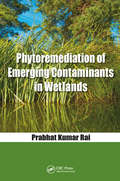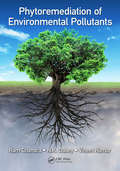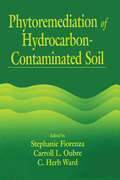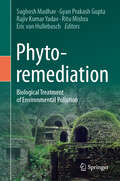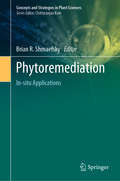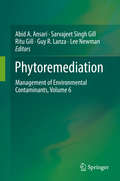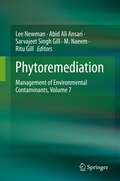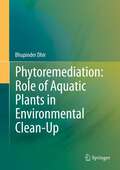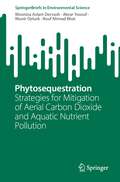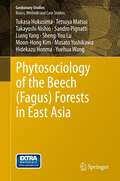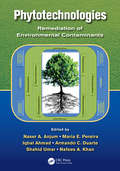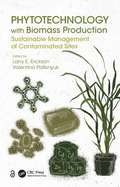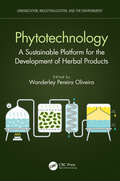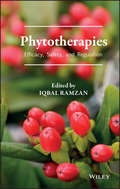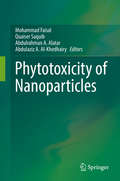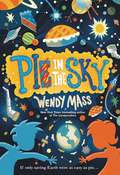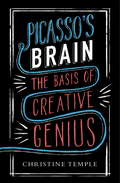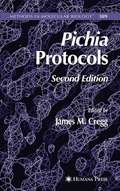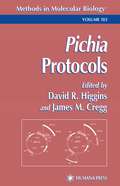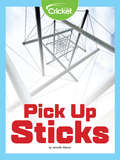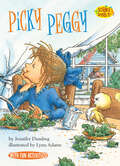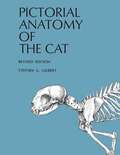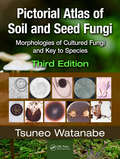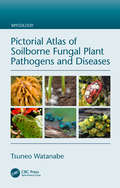- Table View
- List View
Phytoremediation of Emerging Contaminants in Wetlands
by Prabhat Kumar RaiPhytoremediation with wetland plants is an eco-friendly, aesthetically pleasing, cost-effective, solar-driven, passive technique that is useful for cleaning up environmental pollutants with low to moderate levels of contamination.
Phytoremediation of Environmental Pollutants
by Vineet Kumar Ram Chandra N.K. DubeyPhytoremediation aids to augment bioremediation as it uses broad range plants to remediate soil, sediment, surface water and ground water that have been contaminated with toxic metals, organic, pesticides and radionuclides. This book serves to disseminate detailed up to date knowledge regarding the various aspects of phytoremediation and plant-microbe interaction. The book highlights process and molecular mechanisms for industrial waste detoxification during phytoremediation in wetland plants, role of endophytic bacteria for phytoremediation of environmental pollutants, constructed wetland treatment system for treatment and recycling of hazardous wastewater, amongst other relevant topics. Key Features: Focuses on phytoremediation process for different pollutants, mainly heavy metal detoxification in the presence of other co-pollutants. Includes plant-soil-microbe interactions in phytoremediations and remediation of contaminated water. Explores life cycle assessment of industrial waste contaminated site with organic pollutants. Discusses hyperaccumulator versus non-hyperaccumulator plants for environmental waste management. Includes bacterial assisted phytoremediation and siderophore formation in specific environmental conditions.
Phytoremediation of Hydrocarbon-Contaminated Soils (Aatdf Monograph Ser. #2)
by C. H. Ward Carroll L. Oubre Stephanie FiorenzaInterest in phytoremediation as a solution for contaminants in groundwater and soil has exploded. The project documented in Phytoremediation of Hydrocarbon Contaminated Soils presents innovative technology for environmental clean up using in situ treatment. It describes the results of a field study focusing on hydrocarbon contamination, especially polynuclear aromatic hydrocarbons, in surface and near surface soils.The field demonstration used soils contaminated with aged diesel fuels. The random block design enabled the investigators to test the statistical difference in the effects of different vegetated and unvegetated treatments. They tested the degradation of diesel and polynuclear aromatic hydrocarbon components in plots containing three different vegetation treatments, two grasses and a legume, and a non-vegetated control.Part one of the monograph gives a complete and thorough account of the results of the field study. Part two covers the design and potential costs of a full-scale implementation of the demonstration system as well as the performance and potential application of the new technology. Phytoremediation of Hydrocarbon Contaminated Soils supplies quantitative results about the use of vegetation in soil remediation. The information given on the niches and limitations of the technologies allows for a more informed selection of remedial solutions for environmental cleanup.
Phytoremediation: Biological Treatment of Environmental Pollution
by Sughosh Madhav Eric Van Hullebusch Gyan Prakash Gupta Rajiv Kumar Yadav Ritu MishraThis book covers the fundamentals, limitations, and challenges of phytoremediation in contaminated water, air, and soil due to rapid demographic and industrial development. This foundational knowledge is necessary to combat negative impacts on human and environmental health brought on by practices such as ore mining, gas emission, pesticide application, and municipal waste generation. The book explains the phytoremediation of organic and inorganic pollutants via different types of microbes, fungi, and various plant groups to improve the quality of contaminated systems, and discusses emerging advancements and technologies, such as nanotechnology, for reducing toxic pollution. The mechanisms of phytoremediation are a primary point of focus to understand the basics, and for readers to apply this knowledge in a variety of contexts where phytoremediation is a useful tool in improving the quality of polluted water, air, and soil. The book is mainly intended for researchers in the fields of botany, agriculture, biotechnology, and environmental engineering, but will also be of interest to policymakers, NGOs, and academics working on environmental management.
Phytoremediation: In-situ Applications (Concepts and Strategies in Plant Sciences)
by Brian R. ShmaefskyThis book provides in-situ phytoremediation strategies that are particularly well suited for developing nations. Its goal is to promote the use of field-tested phytoremediation methods for removing soil and water pollutants from agricultural, industrial, military, and municipal sources. These strategies include using algae and a variety of aquatic and terrestrial plants. The book subsequently discusses the use of crops and native plants for phytoremediation, and how phytoremediation efforts impact the rhizosphere. After having finished the book, readers will be able to directly adapt the strategies described here for their specific purposes.
Phytoremediation: Management of Environmental Contaminants, Volume 6
by Sarvajeet Singh Gill Ritu Gill Guy R. Lanza Lee Newman Abid A. AnsariThis text details the plant-assisted remediation method, “phytoremediation”, which involves the interaction of plant roots and associated rhizospheric microorganisms for the remediation of soil contaminated with high levels of metals, metalloids, fuel and oil hydrocarbons, nano particles, pesticides, solvents, organic compounds and various other contaminants. Many chapters highlight and compare the efficiency and economic advantages of phytoremediation and nano-phytoremediation to currently practiced soil and water treatment practices.Volume 6 of Phytoremediation: Management of Environmental Contaminants continues the series. Taken together, the six volumes provide a broad–based global synopsis of the current applications of phytoremediation using plants and the microbial communities associated with their roots to decontaminate terrestrial and aquatic ecosystems.
Phytoremediation: Management of Environmental Contaminants, Volume 7
by Sarvajeet Singh Gill Ritu Gill M. Naeem Abid Ali Ansari Lee NewmanThe accumulation of large amounts of contaminants occurs in the environment due to industrialization and various other anthropogenic activities. Contaminants ultimately affect human health worldwide. Organic, inorganic, and radioactive substances are the prevalent forms of environmental contaminants and their complete remediation in soils and sediments is rather a difficult task. Concerns of their toxicities led to the emphasis on development of effective techniques to assess the presence and mobility of contaminants in air, water, and soil. Furthermore, the ever-increasing concentration of toxic pollutants in the environment is considered a serious threat to plant, animal, human, and environmental health.Many technologies are in use to clean and eliminate hazardous contaminants from the environment; however, these technologies can be costly, labor intensive, and often distressing to the general public. Phytoremediation is a simple, cost effective, environmentally friendly and fast-emerging new technology for eliminating toxic contaminants from different environments. Phytoremediation refers to the natural ability of certain plants and their associated microbiome (including hyper-accumulators or bio-accumulators) to remove, degrade, or render contaminants harmless. Through this technique, certain species of plants flourish by accumulating contaminants present in the environment. The unique and selective uptake capabilities of plant root and shoot systems, effective translocation, bioaccumulation, and contaminant degradation capabilities of the accumulator plants are utilized in phytoremediation techniques. Phytotechnologies involving the use of plants for contaminant removal gained importance during the last two decades and phytoremediation technology became an effective tool for environmental detoxification because of plants ability to accumulate the contaminants at very high concentrations.Phytoremediation strategies can remove, degrade, or stabilize inorganic and organic contaminants entering a multitude of ecosystems using green plants and their associated microbial communities. The development and use of phytotechnologies continues to move forward at a steady pace. Researchers recognize the potential of phytoremediation to offer a green, cost effective, eco-friendly and feasible application to address some of the world’s many environmental challenges. This book provides significant information to add to the previous volumes published on the topic and can serve as the foundation for the development of new applications that feature the integration of modern research discoveries into new methods to remediate contaminated ecosystems. Moreover, this volume brings recent and established knowledge on different aspects of phytoremediation and nano-phytoremediation, providing this information in a single source that offers a cutting-edge synthesis of scientific and experiential knowledge on polluted environments that is useful for policy makers, practitioners and scientists, and engineers.Phytoremediation: Management of Environmental Contaminants, Volume 7 highlights the various prospects that are involved in current global phytoremediation research. This book delivers a content-rich source to the reader and can act as a platform for further research studies. It should meet the needs of all researchers working in, or have an interest in this particular field.
Phytoremediation: Role of Aquatic Plants in Environmental Clean-Up
by Bhupinder DhirContamination of the different components of environment through industrial and anthropogenic activities have guided new eras of research. This has lead to development of strategies/methodologies to curtail/minimize environmental contamination. Research studies conducted all over the globe established that bioremediation play a promising role in minimizing environmental contamination. In the last decade, phytoremediation studies have been conducted on a vast scale. Initial research in this scenario focused on screening terrestrial plant species that remove contaminants from soil and air. Later, scientific community realized that water is a basic necessity for sustaining life on earth and quality of which is getting deteriorated day by day. This initiated studies on phytoremediation using aquatic plants. Role of aquatic plant species in cleaning water bodies was also explored. Many of the aquatic plant species showed potential to treat domestic, municipal and industrial wastewaters and hence their use in constructed wetlands for treating wastewaters was emphasized. The present book contains five chapters. First two chapters provide information about types of contaminants commonly reported in wastewaters and enlists some important and well studied aquatic plant species known for their potential to remove various contaminants from wastewater. Subsequent chapters deal with mechanisms involved in contaminant removal by aquatic plant species, and also provide detailed information about role of aquatic plant species in wetlands. Potential of constructed wetlands in cleaning domestic and industrial wastewaters has also been discussed in detail. The strategy for enhancing phytoremediation capacity of plants by different means and effectiveness of phytoremediation technology in terms of monitory benefits has been discussed in last chapter. Last chapter also emphasizes the future aspects of this technology.
Phytosequestration: Strategies for Mitigation of Aerial Carbon Dioxide and Aquatic Nutrient Pollution (SpringerBriefs in Environmental Science)
by Munir Ozturk Rouf Ahmad Bhat Abrar Yousuf Moonisa Aslam DervashMost imperative environmental concerns are Cultural eutrophication pertaining to industrialization and urbanization which lead to proliferation of weeds in aquatic environs disturbing these ecosystems. Alarming increase in CO2, CH4, CFC’s, N2O and water vapour in the atmosphere cause enhanced greenhouse effect, among all these CO2 is accountable for 55-60 % of total enhanced effect. Phyto- and Nutrient sequestration via plants helps storage of atmospheric CO2 in the vegetation to get rid of contaminants. Carbon and nutrient sequestration can be braided together for sustainable development goals. The chapters adopt the hierarchy as follows: significance of quality environs, quantification and bio-monitoring of culprit contaminants, the issues relevant to global warming and accelerated eutrophication and their ecological impacts followed by various sequestration technologies.
Phytosociology of the Beech (Fagus) Forests in East Asia
by Sandro Pignatti Hidekazu Honma Tetsuya Matsui Tukasa Hukusima Takayoshi Nishio Masato Yoshikawa Liang Yang Sheng-You Lu Moon-Hong Kim Yuehua WangThis book describes the mountain forests of East Asia (Korea, Japan, China and Taiwan), the tree layers of which contain different species of the genus Fagus. The vegetation is primarily deciduous in the northern regions, whereas in South China evergreen trees can also be found: a total of 21 plant communities are described, with data on species composition, dominance, geographical distribution and ecology. A general comparison is provided by synoptic Table 1, which details the frequencies of ca. 1500 species growing in the Fagus forests; biodiversity and evolution are discussed. The book, which is the fruit of a major international collaboration, presents a synthesis of extended original investigations by the authors and hardly accessible specialist literature.
Phytotechnologies: Remediation of Environmental Contaminants
by Iqbal Ahmad Shahid Umar Naser A. Anjum Armando C. Duarte Nafees A. Khan Maria E. PereiraPhytotechnologies: Remediation of Environmental Contaminants highlights the use of natural and inherent traits of plants and associated microbes to exclude, accumulate, or metabolize a variety of contaminants, with the goal of efficiently and sustainably decontaminating the biosphere from unwanted hazardous compounds. Contributed by an internationa
Phytotechnology with Biomass Production: Sustainable Management of Contaminated Sites
by Larry E. Erickson Valentina PidlisnyukThis book explains the concept of using phytotechnology with biomass production to improve soil quality and restore contaminated sites to a useful state that has economic and social value. Phytotechnology with Biomass Production: Sustainable Management of Contaminated Sites focuses on the application of second-generation biofuel crops, primarily Miscanthus, to slightly contaminated or marginal postmilitary and postmining soils. Based on recent and ongoing research from the United States, Ukraine, the Czech Republic, and Germany, along with case studies from other countries, this is the first comprehensive book on using phytotechnology with biomass production at contaminated sites at a global level. FEATURES Focuses on an important topic of a growing global activity: soil improvement through biomass production Includes case studies and success stories from different countries on application of Miscanthus phytotechnology to sites differently contaminated by trace elements, pesticides, and petroleum products Discusses the peculiarities of Miscanthus production on postmilitary and postmining contaminated lands and the impact of plant growth regulators, soil amendments, fertilizers, and biochar to the process Introduces soil fauna as indicators of soil health during Miscanthus phytotechnology application Presents Miscanthus value chain associated with the processing of Miscanthus biomass to different bioproducts While written primarily for faculty, students, research scientists, environmental and agricultural professionals, gardeners, farmers, landowners, and government officials, this book has value for all who are working on phytotechnology projects and phytomining to reduce risk and/or improve soil quality at contaminated sites. Phytotechnology with Biomass Production: Sustainable Management of Contaminated Sites is also a great new resource for those who are new to the topic and want to learn to apply phytotechnologies and biomass production with further conversion into energy and bioproducts.
Phytotechnology: A Sustainable Platform for the Development of Herbal Products (Urbanization, Industrialization, and the Environment)
by Wanderley Pereira OliveiraHerbal products have traditionally been used in several industrial sectors and have gained a notable reputation in recent years due to the current trend in society, which seeks natural, healthier, and more sustainable products. The processing of these products, however, is multiplex but important for the production of a high-quality standardised product. Phytotechnology: A Sustainable Platform for the Development of Herbal Products highlights the complex, multidisciplinary process of phytopharmaceutical technology used to create herbal remedies. Organised into four parts, various experts in the field clearly and objectively address the fundamental and technological concepts involved in the manufacturing of high-quality herbal products. Additional Features Emphasises how herbal products have traditionally been used in several industrial sectors, including pharmaceutical science, food, cosmetics, chemical engineering, and agroindustry Provides a much-needed update of the current information regarding phytopharmaceutical technology and focuses on industrial applications Written using a multidisciplinary approach, to include all subjects involved in the processing of herbal products The information presented is valuable reference material for professionals of different specialties who wish to enter this fascinating and innovative area.
Phytotherapies: Efficacy, Safety, and Regulation
by Iqbal RamzanCovering fundamentals and new developments in phytotherapy, this book combines pharmaceutical sciences and chemistry with clinical issues. • Helps readers better understand phytotherapy and learn the fundamentals of and how to analyze phytotherapeutic agents • Discusses phytotherapy in modern medicine, chemoprevention of disease, and alternatives to western medicines for specific diseases • Chapters summarizes the uses and applications of phytomedicines, by type like Chinese, Greco-Arab, Indian, European, and Ayurvedic • Includes international regulatory perspectives and discusses emerging regulations for various established and emerging markets
Phytotoxicity of Nanoparticles
by Quaiser Saquib Mohammad Faisal Abdulaziz A. Al-Khedhairy Abdulrahman A. AlatarThis book provides relevant findings on nanoparticles’ toxicity, their uptake, translocation and mechanisms of interaction with plants at cellular and sub-cellular level. The small size and large specific surface area of nanoparticles endow them with high chemical reactivity and intrinsic toxicity. Such unique physicochemical properties draw global attention of scientists to study potential risks and adverse effects of nanoparticles in the environment. Their toxicity has pronounced effects and consequences for plants and ultimately the whole ecosystem. Plants growing in nanomaterials-polluted sites may exhibit altered metabolism, growth reduction, and lower biomass production. Nanoparticles can adhere to plant roots and exert physicochemical toxicity and subsequently cell death in plants. On the other hand, plants have developed various defense mechanisms against this induced toxicity. This books discusses recent findings as well as several unresolved issues and challenges regarding the interaction and biological effects of nanoparticles. Only detailed studies of these processes and mechanisms will allow researchers to understand the complex plant-nanomaterial interactions.
Pi in the Sky
by Wendy MassJoss is the seventh son of the Supreme Overlord of the Universe, and all he gets to do is deliver pies. That's right: pies. Of course these pies actually hold the secrets of the universe between their buttery crusts, but they're still pies.Joss comes from a family of overachievers, and is happy to let his older brothers shine. But when Earth suddenly disappears, Joss is tasked with the not-so-simple job of bringing it back. With the help of an outspoken girl from Earth named Annika, Joss embarks on the adventure of a lifetime and learns that the universe is an even stranger place than he'd imagined.
Picasso's Brain: The basis of creative genius
by Christine TempleWhere does creativity come from? Why are some people more creative than others?Eminent neuropsychologist Christine Temple navigates a wide range of factors from the hard science (visual memory, spatial ability, brain functions) to the environmental (the 'mad genius' myth, and Gladwell's 10,000 hours of practice) in her study of what contributes to creativity. Using Pablo Picasso as her model of a creative genius, she weighs up each theory as it applies to Picasso and shows how his own creativity came from a combination of many factors.In this book, she looks at Picasso's playful mindset and passionate relationships, investigates the possibility that genius is genetic and can be inherited in families, considers whether creative genii perceive the world in a different way, and determines whether single-mindedness and focus play a part. This is the first book to look at a multitude of traits in creativity, and nail down the key factors that matter (and also which ones don't) to provide an overall picture of this fascinating area, linking the science to the personal.
Picasso's Brain: The basis of creative genius
by Christine TempleWhere does creativity come from? Why are some people more creative than others?Eminent neuropsychologist Christine Temple navigates a wide range of factors from the hard science (visual memory, spatial ability, brain functions) to the environmental (the 'mad genius' myth, and Gladwell's 10,000 hours of practice) in her study of what contributes to creativity. Using Pablo Picasso as her model of a creative genius, she weighs up each theory as it applies to Picasso and shows how his own creativity came from a combination of many factors.In this book, she looks at Picasso's playful mindset and passionate relationships, investigates the possibility that genius is genetic and can be inherited in families, considers whether creative genii perceive the world in a different way, and determines whether single-mindedness and focus play a part. This is the first book to look at a multitude of traits in creativity, and nail down the key factors that matter (and also which ones don't) to provide an overall picture of this fascinating area, linking the science to the personal.
Pichia Protocols
by James M. CreggThis book focuses on recent developments of Pichia pastoris as a recombinant protein production system. Highlighted topics include a discussion on the use of fermentors to grow Pichia pastoris, information on the O- and N-linked glycosylation, methods for labeling Pichia pastoris expressed proteins for structural studies, and the introduction of mutations in Pichia pastoris genes by the methods of restriction enzyme-mediated integration (REMI). Each chapter presents cutting-edge and cornerstone protocols for utilizing P. pastoris as a model recomibinant protein production system. This volume fully updates and expands upon the first edition.
Pichia Protocols (Methods in Molecular Biology #103)
by James Cregg David R. HigginsDavid Higgins and James Cregg compile for the first time an all-inclusive collection of key experimental procedures to manipulate Pichia pastoris for gene expression purposes. The methods-developed by world-class researchers in their own laboratories-contain detailed descriptions of available expression strains, as well as vectors and step-by-step instructions for the construction of expression strains and for their use in the production of foreign proteins from shake-flask or fermentor cultures. General procedures for the purification of foreign proteins are also provided, along with protocols for analyzing foreign protein products for glycosylation and subcellular location. Its detailed instructions will permit any researcher in molecular biology to quickly construct an expression strain that will produce a desired foreign protein, and to use this state-of-the-art molecular and cellular biological system successfully in every area of biological research today.
Pick Up Sticks
by Jennifer MasonWould you believe that two NASA scientists used a baby toy to inspire their design for the next generation of space explorers? Read on to learn about how Adrian Agogino and Vytas SunSpiral designed the SUPERball Bot and what their plans are for the future.
Picky Peggy (Science Solves It!)
by Jennifer DusslingSolve kid-sized dilemmas and mysteries with the Science Solves It! series. These fun books for kids ages 5–8 blend clever stories with real-life science. Why did the dog turn green? Can you control a hiccup? Is that a UFO? Find the answers to these questions and more as kid characters dive into physical, life, and earth sciences. When Mr. Cooper gives Peggy a new baby duck, she promises to take good care of it. But when Fluff's feathers begin to droop and his eyes are no longer bright and shiny, Peggy discovers why and learns that good nutrition is very important - for growing ducks and growing girls! Books in this perfect STEM series will help kids think like scientists and get ahead in the classroom. Activities and experiments are included in every book! (Level One; Science topic: Nutrition)
Pictorial Anatomy Of The Cat
by Stephen G. GilbertThis book is designed for use as a dissection guide in comparative vertebrate anatomy or in mammalian anatomy. The material covered and the time allotted to such courses varies considerably, and the illustrations are therefore designed to enable the instructor to point out the important features of areas which cannot be dissected in detail by every student.
Pictorial Atlas of Soil and Seed Fungi: Morphologies of Cultured Fungi and Key to Species,Third Edition (Mycology)
by Tsuneo WatanabeThis third edition describes and illustrates more than 515 fungal species, including 49 oomycetous, 35 zygomycetous, 49 ascomycetous, 38 basidiomycetous, and 344 anamorphic species. All fungi are described alphabetically in order of Oomycota, Zygomycota, Ascomycota, Basidiomycota, and Anamorphic (Deuteromycetous) fungi. For each genus, the atlas includes type species, references, morphology, and materials. The book illustrates all fungi alongside morphologies and colonies of their fresh agar cultures or dried specimens, providing ready access to morphologically similar fungi for quick comparison. This edition also contains a bonus CD-ROM, which includes color versions of all images from the book.
Pictorial Atlas of Soilborne Fungal Plant Pathogens and Diseases (Mycology #34)
by Tsuneo WatanabeThe Pictorial Atlas of Soilborne Fungal Plant Pathogens and Diseases describes the soilborne fungal diseases caused by Oomycetes, Zygomycetes, Ascomycetes, Basidiomycetes, and Deuteromycetous (Anamorphic) fungi. Soilborne fungal diseases are significant as both environmental and agricultural problems, yet it is difficult to understand the ecology of pathogenic fungi and its effective control. This book provides very detailed information on many of the commonly and not so commonly encountered groups of soilborne fungi diseases. It will be a useful reference for those teaching and conducting research in mycology, plant pathology, soilborne plant diseases, and the ecology of fungal communities.
